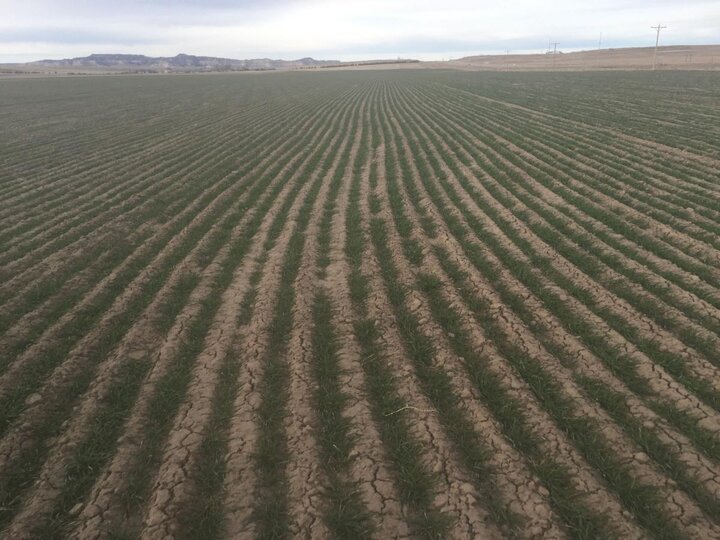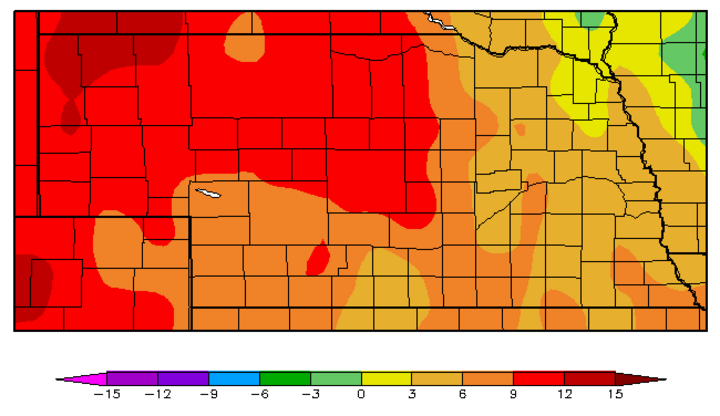February 23, 2016
With generally above normal February temperatures and little snow cover in much of western Nebraska, some growers are asking whether winter wheat that’s starting to grow may be at increased risk for winter injury and winterkill.


Winter wheat in western Nebraska is experiencing March-like temperatures. Average historical high and low temperatures during February in Nebraska Panhandle are 420F and 160F, respectively. Daily high and low temperatures during last two weeks in the region varied from 50 to 750F and 26 to 330F, respectively. High temperatures were as much as 360 above the historical high temperatures for the same period. This results in breaking dormancy and premature spring growth.
This year’s winter wheat is in pretty good condition and is less vulnerable to the winter injury suffered by the 2015 crop, described by some as the worst in 50 years.
This year’s crop is less likely to face severe injury from recent temperature swings for several reasons:
- There was good moisture for planting and fall growth in 2015. The previous year wheat was planted in dry conditions with limited moisture in the fall. Dry soil warms up and cools down about six times faster than moist soil, creating a wider and faster fluctuation of temperatures that is hard on crowns and roots.
- Moist soil allows for better planting conditions and seed placement. In 2014 soils were hard and dry and seed often wasn’t planted to the recommended depth, meaning that crowns formed closer to the surface where they were more vulnerable to cold air extremes.
- Fall 2015 growth was good and plants had a chance to winter harden (vernalize) before the cold set in. These bigger plants also provide better protection from wind erosion that can injure plants; however, bigger plants may lose some of their winter hardiness before smaller plants would. (Figure 1).
One of the biggest concerns now is for plants that start growing earlier than normal because of warmer temperatures and then experience a rapid decrease in air temperature with little snow cover. This change from above normal temperatures to freezing temperatures in a short period of time is when winter kill is most likely to happen. The greater number of wild temperature swings that occur throughout the spring the greater the risk for winter kill.
On the other hand, swings in temperature that occur over the course of a few days are more likely to only kill the top growth without causing significant damage to the plant. If the plant’s first node is above ground at the time of a hard freeze, the stem and spike would usually be killed, but the plant could come right back from the secondary tillers and produce good yield. The crown is set and the plants are growing and putting energy into the roots and secondary tillers. Damage to the stem and spike would be similar to that from an early hail storm or feeding cattle.
Several factors may contribute to winter injury or winter kill, including lack of rain, lack of snow/snow cover, fluctuating high-low temperatures, loose seed beds, crop residue, seeding date, hoe or disk drill, seeding depth, soil type and quality, fallow practices, terraces, field edges, field exposure or silt blown into a field due to high winds. Also, this year with the early February snow and rains, there may be pockets of serious damage in low-lying areas where water pooled and refroze around plants, making it impossible for them to breathe.
If severe winter injury or winterkill is suspected, give plants an opportunity to recover before assessing damage or tearing out a field. Also consider plant-back restrictions on any herbicides already applied to the field.
Photoperiod Sensitive Wheat Varieties
Historically all of the wheat varieties planted in Nebraska were photoperiod sensitive, which meant stem elongation and transition to reproductive stage (head initiation) depended on day length rather than temperature. Photoperiod sensitive plants don’t start growing during really warm January days because there just isn’t enough daylight to trigger growth. When a hard freeze occurred in February, they were less likely to be injured. Further south, the wheat varieties used are not photoperiod sensitive, while states north of Nebraska still use these varieties.
In recent years, as the climate has shifted to warmer temperatures, wheat grown in Nebraska has become less photoperiod sensitive and has become more temperature driven. If there are no really hard freezes, wheat lines that are temperature driven will have an advantage as they often get a quicker start in the spring. This year lines that are photoperiod sensitive may initiate growth later and have a shorter reproductive time, possibly contributing to lower yield. However, if there is a hard freeze, the opposite will be true. Historically, it has been beneficial to be photoperiod sensitive, but with climate change, the risks are decreasing.
P. Stephen Baenziger
UNL Professor of Agronomy, Wheat Breeder
Robert Klein
Western Nebraska Extension Crops Specialist
Dipak Santra
UNL Alternative Crops Breeder, Panhandle REC
Cody Creech
Extension Dryland Cropping Systems Specialist, Panhandle REC
